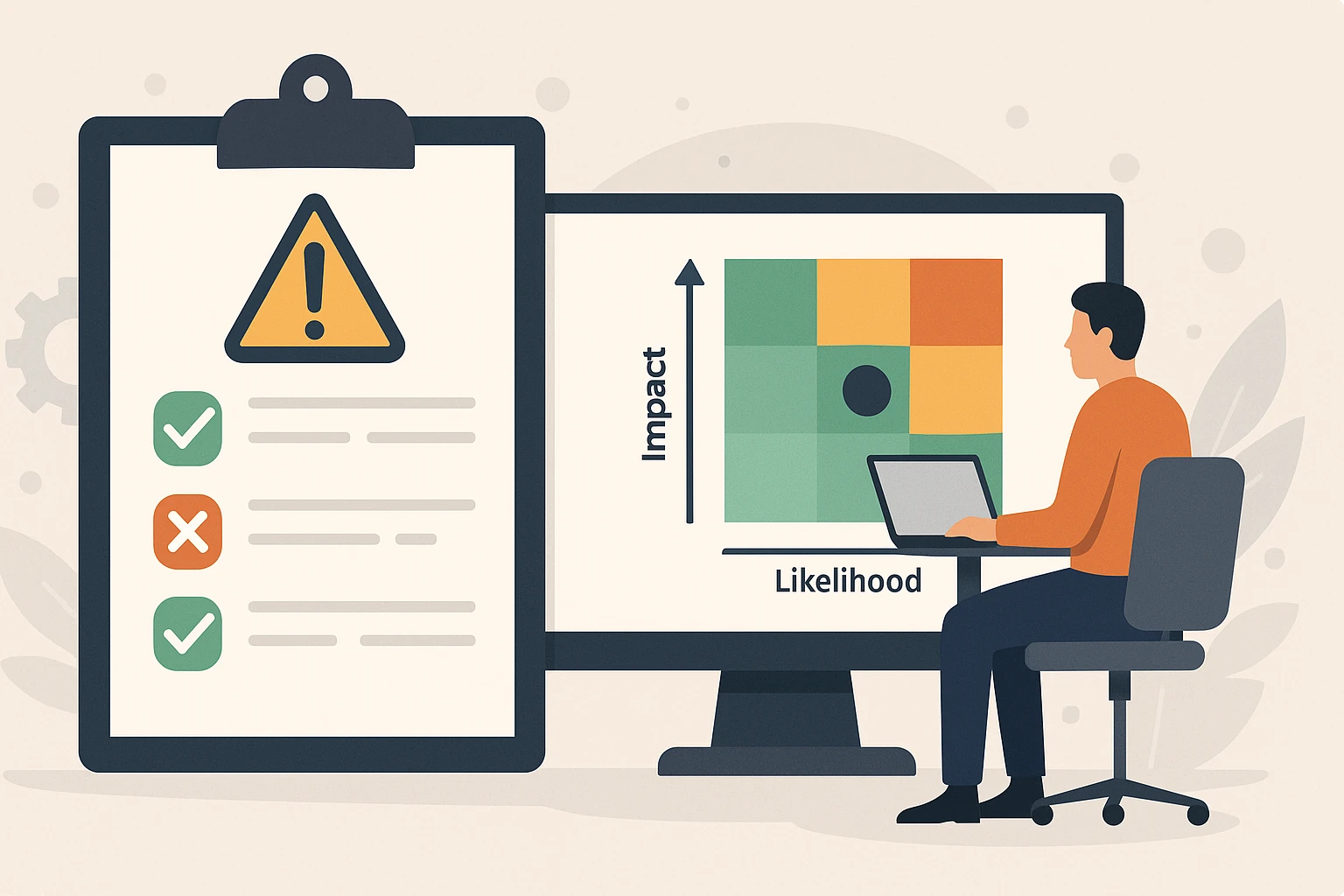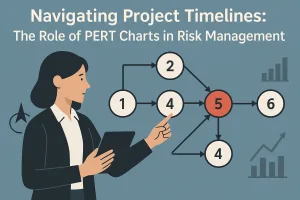Introduction to Risk Assessment in Software Project Management
Risk management is a critical discipline that involves identifying, analyzing, and responding to potential risks that could impact the success of a project. The significance of risk management in software projects cannot be overstated, as it helps ensure that projects are delivered on time, within budget, and meet the desired quality standards. Given the inherent uncertainties in software development, effective risk management is essential for navigating challenges and achieving project objectives.
The Role of Risk Assessment in the Project Lifecycle
Risk assessment plays a pivotal role throughout the project lifecycle. It serves as a proactive measure that allows project managers and teams to identify potential risks early on, assess their impact, and develop strategies to mitigate them. This process typically involves several key steps:
- Risk Identification: Recognizing potential risks that could affect the project, including technical challenges, resource constraints, and external factors.
- Risk Analysis: Evaluating the likelihood and potential impact of identified risks, which helps prioritize them based on their significance.
- Risk Response Planning: Developing strategies to address the identified risks, whether through avoidance, mitigation, transfer, or acceptance.
- Monitoring and Review: Continuously tracking risks throughout the project to ensure that response strategies remain effective and to identify new risks as they arise.
By integrating risk assessment into the project lifecycle, teams can make informed decisions that enhance project resilience and adaptability.
Qualitative and Quantitative Methods in Risk Assessment
When it comes to risk assessment methodologies, two primary approaches are commonly employed: qualitative and quantitative methods. Each approach has its strengths and is suited to different aspects of risk management.
- Qualitative Risk Assessment: This approach focuses on the subjective evaluation of risks based on expert judgment and experience. It typically involves categorizing risks as high, medium, or low based on their potential impact and likelihood. Qualitative methods are particularly useful in the early stages of a project when detailed data may be scarce. They allow teams to quickly identify and prioritize risks, facilitating timely decision-making.
- Quantitative Risk Assessment: In contrast, quantitative methods rely on numerical data and statistical analysis to assess risks. This approach involves calculating the probability of risks occurring and their potential impact on project objectives, often expressed in monetary terms. Quantitative assessments provide a more objective basis for decision-making and can be particularly valuable in complex projects where precise data is available. Techniques such as Monte Carlo simulations and decision tree analysis are commonly used in this approach.
Risk assessment is a fundamental component of software project management that enables teams to navigate uncertainties effectively. By employing both qualitative and quantitative methods, risk managers and project analysts can develop a comprehensive understanding of potential risks and implement strategies that enhance project success.
Understanding Risk Assessment Techniques
Risk assessment techniques are systematic methods used to identify, analyze, and respond to potential risks that could impact a project. These techniques play a crucial role in ensuring that projects are completed on time, within budget, and to the desired quality standards.
Definition of Risk Assessment Techniques
Risk assessment techniques can be broadly categorized into qualitative and quantitative approaches. Qualitative techniques involve subjective judgment and are often used to prioritize risks based on their potential impact and likelihood. Examples include brainstorming sessions, expert interviews, and risk matrices. On the other hand, quantitative techniques rely on numerical data and statistical methods to measure risks, such as decision trees, Failure Modes and Effects Analysis (FMEA), and Monte Carlo simulations. Each technique serves a specific purpose and can be selected based on the project’s needs and complexity [1][3].
Purpose of Risk Assessment
The primary purpose of risk assessment in project management is to identify potential risks early in the project lifecycle. This proactive approach allows project managers to analyze the risks in terms of their probability and impact, enabling them to prioritize which risks require immediate attention. By understanding the nature of these risks, project teams can develop appropriate response strategies, whether that involves mitigation, transfer, acceptance, or avoidance. Effective risk assessment not only helps in safeguarding project objectives but also enhances informed decision-making throughout the project [1][2][5].
Choosing the Right Technique
Selecting the appropriate risk assessment technique is critical and should be based on the specific context of the project. Factors such as project size, complexity, available data, and stakeholder expectations can influence this decision. For instance, a small project with limited resources may benefit from qualitative techniques that require less data and are easier to implement. Conversely, larger, more complex projects may necessitate quantitative methods that provide a more detailed analysis of risks and their potential impacts [4][12].
Understanding and effectively utilizing risk assessment techniques is essential for risk managers and project analysts. By defining these techniques, recognizing their purpose, and choosing the right approach based on project context, teams can significantly enhance their ability to manage risks and ensure project success.
Qualitative Risk Assessment Techniques
Qualitative risk assessment is a critical component of risk management in software project management, focusing on the evaluation of risks based on their likelihood and potential impact rather than relying on numerical data. This approach is particularly useful in scenarios where quantitative analysis may be impractical or too resource-intensive. Below, we delve into the definition, key characteristics, common techniques, practical applications, and the strengths and weaknesses of qualitative risk assessment.
Definition and Key Characteristics
Qualitative risk assessment is the process of evaluating and rating identified risks based on their severity and the likelihood of their consequences. It emphasizes understanding the nature of risks through non-numerical means, allowing project managers to prioritize risks effectively and develop appropriate mitigation strategies. Key characteristics include:
- Subjective Evaluation: Relies on the judgment and experience of project team members to assess risks.
- Focus on Severity and Likelihood: Evaluates risks based on their potential impact on project objectives and the probability of occurrence.
- Simplicity and Speed: Generally quicker and less costly than quantitative assessments, making it suitable for fast-paced project environments [3][13].
Common Qualitative Techniques
Several techniques are commonly employed in qualitative risk assessment, including:
- Risk Probability and Impact Matrix: This tool helps project teams visualize and prioritize risks by plotting them on a matrix that considers both the likelihood of occurrence and the potential impact on the project. Risks are categorized into different levels, allowing teams to focus on the most critical threats [5][9].
- Risk Categorization: This technique involves grouping risks into categories (e.g., technical, organizational, external) to facilitate better understanding and management. By categorizing risks, project managers can identify patterns and allocate resources more effectively [1][15].
- Expert Judgment: Leveraging the insights of experienced team members or stakeholders can provide valuable perspectives on potential risks. This technique often involves structured interviews or brainstorming sessions to gather expert opinions on risk likelihood and impact [1][7].
Practical Applications in Software Projects
Qualitative risk assessment methods can be effectively applied in various stages of software project management:
- Early Project Phases: During the initial planning stages, qualitative techniques can help identify potential risks related to project scope, technology choices, and resource availability. For instance, a risk probability and impact matrix can be used to prioritize risks associated with new technology adoption [4][6].
- Ongoing Risk Monitoring: As the project progresses, qualitative assessments can be revisited to evaluate new risks that may arise or changes in the likelihood and impact of previously identified risks. Regular expert judgment sessions can help keep the risk management process dynamic and responsive [8][13].
Strengths and Weaknesses of Qualitative Approaches
Strengths:
– Cost-Effective: Qualitative assessments are generally less resource-intensive than quantitative methods, making them accessible for projects with limited budgets [3][4].
– Flexibility: These techniques can be adapted to various project contexts and are suitable for projects at different stages of development [15].
– Enhanced Understanding: By focusing on the nature of risks, qualitative methods can provide deeper insights into potential issues, fostering better communication among team members [8][13].
Weaknesses:
– Subjectivity: The reliance on personal judgment can lead to biases and inconsistencies in risk evaluation, potentially overlooking critical risks [6][13].
– Limited Precision: Qualitative assessments may lack the detailed numerical data that quantitative methods provide, which can be a drawback in high-stakes projects where precise risk quantification is essential [3][4].
Qualitative risk assessment techniques play a vital role in software project management by enabling teams to identify, evaluate, and prioritize risks effectively. While they offer several advantages, it is essential to be aware of their limitations and consider integrating them with quantitative methods for a more comprehensive risk management strategy.
Quantitative Risk Assessment Techniques
Quantitative risk assessment is a systematic approach used in project management to evaluate risks by converting their potential impact into numerical terms. This method allows project managers to make informed decisions based on statistical data and mathematical models, providing a clearer picture of the risks involved in a project. Here are the key features and methodologies associated with quantitative risk assessment:
Definition and Unique Features
- Quantitative Risk Assessment: This technique involves the use of statistical methods to analyze the likelihood and impact of identified risks. It quantifies risks in terms of cost, time, and other measurable factors, enabling project managers to prioritize risks based on their potential impact on project objectives.
- Unique Features: Unlike qualitative assessments, which categorize risks based on subjective judgment, quantitative assessments provide a more objective analysis. This is achieved through numerical data, allowing for precise calculations and projections regarding risk exposure and potential outcomes.
Common Quantitative Techniques
- Monte Carlo Simulation: This technique uses random sampling and statistical modeling to estimate the probability of different outcomes in a project. By simulating a range of scenarios, project managers can assess the likelihood of various risks and their potential impacts on project timelines and budgets.
- Application Example: In a software development project, Monte Carlo simulations can be used to predict the completion time by accounting for uncertainties in task durations and resource availability.
- Decision Tree Analysis: Decision trees provide a visual representation of decisions and their possible consequences, including risks and rewards. This method helps in evaluating different strategies by mapping out potential outcomes and their probabilities.
- Application Example: A project analyst might use a decision tree to evaluate whether to invest in additional testing resources for a software project, weighing the costs against the potential benefits of reducing defects.
- Sensitivity Analysis: This technique assesses how sensitive a project’s outcomes are to changes in input variables. By altering one variable at a time, project managers can identify which risks have the most significant impact on project success.
- Application Example: In a software project, sensitivity analysis can help determine how changes in team productivity or feature complexity affect the overall project timeline.
Strengths and Weaknesses of Quantitative Approaches
- Strengths: Data-Driven Decisions: Quantitative methods provide a solid foundation for decision-making based on empirical data, reducing reliance on intuition.
- Clear Risk Prioritization: By quantifying risks, project managers can prioritize them effectively, focusing resources on the most critical areas.
- Scenario Analysis: Techniques like Monte Carlo simulations allow for comprehensive scenario analysis, helping teams prepare for various potential outcomes.
- Weaknesses: Complexity: Quantitative methods can be complex and require a solid understanding of statistical techniques, which may not be readily available in all project teams.
- Data Dependency: The accuracy of quantitative assessments heavily relies on the quality and availability of data. Incomplete or inaccurate data can lead to misleading results.
- Overconfidence in Numbers: There is a risk that project managers may place too much trust in quantitative results, overlooking qualitative factors that could also influence project success.
Quantitative risk assessment techniques such as Monte Carlo Simulation, Decision Tree Analysis, and Sensitivity Analysis provide valuable tools for risk managers and project analysts in software project management. By understanding the strengths and weaknesses of these methodologies, professionals can better navigate the complexities of risk management and enhance their project outcomes.
Comparative Analysis: Qualitative vs. Quantitative Approaches
Within software project management, understanding the nuances between qualitative and quantitative risk assessment techniques is crucial for effective decision-making. Both methodologies serve distinct purposes and can be applied in various scenarios, making it essential for risk managers and project analysts to grasp their differences, advantages, and collaborative potential.
Differences in Methodology
- Qualitative Risk Assessment: This approach is primarily subjective and focuses on identifying risks based on their likelihood and potential impact. It often employs tools such as risk matrices and expert judgment to categorize risks into high, medium, or low levels of severity.
- The qualitative method emphasizes the context of risks, allowing teams to prioritize them based on their potential effect on project objectives. It is particularly useful in the early stages of a project when detailed data may be scarce [12][14].
- Quantitative Risk Assessment: In contrast, quantitative risk assessment relies on numerical data and statistical methods to evaluate risks. This approach aims to quantify the probability of risk events and their potential financial impact, often using techniques such as Monte Carlo simulations or decision tree analysis.
- Quantitative assessments provide a more objective analysis, allowing project managers to make data-driven decisions. This method is beneficial when precise data is available, and the project requires a detailed understanding of potential financial implications [11][13].
Scenarios for Preferred Application
- When to Use Qualitative Assessment: Qualitative assessments are ideal in the initial phases of a project, where the focus is on identifying potential risks without extensive data. They are particularly useful in projects with high uncertainty or when stakeholders need to understand the risk landscape quickly.
- This approach is also beneficial in situations where stakeholder input is crucial, as it allows for discussions and consensus-building around perceived risks [12][14].
- When to Use Quantitative Assessment: Quantitative assessments are preferred in later stages of project planning, especially when detailed data is available. They are essential for projects with significant financial implications, where understanding the exact impact of risks is critical.
- This method is also suitable for projects that require compliance with regulatory standards or when stakeholders demand a rigorous analysis of risk exposure [11][13].
Collaborative Implications of Both Approaches
Utilizing both qualitative and quantitative risk assessment techniques can enhance the overall risk management process. By combining the strengths of each approach, project teams can achieve a more comprehensive understanding of risks:
- Holistic Risk Profile: Qualitative assessments can identify a broad range of risks, while quantitative assessments can provide detailed insights into the most critical risks. This combination allows for a more robust risk profile that informs strategic decision-making.
- Enhanced Communication: Qualitative assessments facilitate discussions among stakeholders, fostering a shared understanding of risks. Quantitative data can then support these discussions with concrete figures, enhancing credibility and clarity [10][12].
- Improved Risk Mitigation Strategies: By leveraging both methodologies, project managers can develop more effective risk mitigation strategies that address both the qualitative aspects of risk perception and the quantitative implications of risk exposure [11][14].
Understanding the differences between qualitative and quantitative risk assessment techniques is vital for effective risk management in software project management. By recognizing when to apply each approach and how they can work together, risk managers and project analysts can better navigate the complexities of project risks, ultimately leading to more successful project outcomes.
Best Practices for Effective Risk Assessment
Effective risk assessment is crucial for ensuring project success and maintaining quality. This section outlines best practices for both qualitative and quantitative risk assessment methodologies, providing actionable guidance for risk managers and project analysts.
Best Practices for Qualitative Risk Assessment
- Stakeholder Involvement: Engage stakeholders early in the risk assessment process. Their insights and experiences can help identify potential risks that may not be immediately apparent. This collaborative approach fosters a sense of ownership and accountability among team members, enhancing the overall risk management process [1].
- Documentation: Maintain thorough documentation of identified risks, their potential impacts, and the rationale behind their assessment. This documentation serves as a reference point for future assessments and helps in tracking the evolution of risks throughout the project lifecycle [1][2].
- Utilize Risk Matrices: Implement risk matrices to categorize and prioritize risks based on their likelihood and impact. This visual tool simplifies the decision-making process and allows teams to focus on the most critical risks [6].
- Regular Review Sessions: Conduct regular brainstorming sessions and review meetings to reassess risks as the project progresses. This ensures that new risks are identified and existing risks are updated based on the current project context [5].
Best Practices for Quantitative Risk Assessment
- Leverage Software Tools: Utilize specialized software tools designed for quantitative risk analysis. These tools can facilitate complex calculations and simulations, providing a more accurate assessment of potential financial impacts and probabilities associated with risks [4][13].
- Data Analysis: Collect and analyze relevant data to inform risk assessments. Historical data, project metrics, and industry benchmarks can provide valuable insights into risk likelihood and impact, enhancing the reliability of quantitative assessments [3][4].
- Scenario Analysis: Conduct scenario analysis to evaluate the potential outcomes of different risk events. This technique helps in understanding the range of possible impacts and aids in developing contingency plans [3].
- Integration with Project Planning: Ensure that quantitative risk assessments are integrated into the overall project planning process. This alignment allows for better resource allocation and prioritization of risk mitigation strategies [2][4].
Importance of Continuous Monitoring and Updating
- Ongoing Risk Assessment: Risk assessments should not be a one-time activity. Continuous monitoring and updating of risk assessments throughout the project lifecycle are essential to adapt to changing circumstances and emerging risks. This proactive approach helps in maintaining project stability and achieving objectives [1][2].
- Feedback Loops: Establish feedback loops to capture lessons learned from risk management activities. This information can be invaluable for future projects, allowing teams to refine their risk assessment methodologies and improve overall project outcomes [2][5].
Conclusion and Future Trends in Risk Assessment
Effective risk assessment is crucial for ensuring project success and minimizing potential setbacks. This blog post has explored the significance of both qualitative and quantitative risk assessment techniques, each offering unique advantages in identifying and managing risks.
- Significance of Qualitative and Quantitative Techniques: Qualitative risk assessment techniques are invaluable for their ability to provide a subjective analysis of risks based on expert judgment and experience. They allow project managers to prioritize risks based on their potential impact and likelihood, facilitating informed decision-making.
- On the other hand, quantitative techniques offer a more data-driven approach, utilizing statistical methods to quantify risks and their potential effects on project outcomes. This method provides a clearer picture of risk exposure and helps in developing more precise mitigation strategies.
- Risk management in software project management is continuously evolving, driven by the increasing complexity of projects and the rapid pace of technological advancements. As software development methodologies, such as Agile and DevOps, gain traction, the need for adaptive and responsive risk management practices becomes paramount. This evolution necessitates a shift towards more integrated risk management frameworks that align with project goals and stakeholder expectations.
- Future Trends in Risk Assessment: Looking ahead, several emerging trends are poised to shape the future of risk assessment methodologies. One of the most significant trends is the integration of automation and artificial intelligence (AI) into risk management processes. These technologies can enhance risk identification and analysis by processing vast amounts of data quickly and accurately, allowing for real-time risk monitoring and response.
- Additionally, the use of predictive analytics is expected to grow, enabling project managers to anticipate potential risks before they materialize. This proactive approach can lead to more effective risk mitigation strategies and ultimately contribute to improved project outcomes.
Both qualitative and quantitative risk assessment techniques play a vital role in the effective management of risks in software projects. As the field continues to evolve, embracing new technologies and methodologies will be essential for risk managers and project analysts to navigate the complexities of modern software development successfully. The future of risk assessment lies in leveraging automation and AI to create more efficient, accurate, and responsive risk management practices.
Find out more about Shaun Stoltz https://www.shaunstoltz.com/about/.
This post was written by an AI and reviewed/edited by a human.



